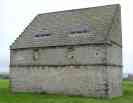Notes On three Nineteenth Century Caithness
Dovecotes
SANDSIDE HOUSE, REAY PARISH
(map ref. NC953653)

BARROCK MAINS STEADING, B0WER PARISH
(map ref. ND283626)
WESTFIELD, HALKIRK PARISH
(map
ref. ND064643)
Dale House Dovecote

Three Caithness Doocotes
Dale House, Westerdale Halkirk Parish
Freswick - Canisbay Parish
Ackergill - Wick Parish

Freswick Dovecote
Forse
Dovecote

Dunbeath Castle Dovecote

Dunbeath Dovecote on Doors Open
Day

Ackergill Castle Dovecotes

Stroma Dovecote

The Stroma Dovecote is part of the
mausaleum |
Dovecotes In
Caithness
Notes by Dunbeath Preservation Trust
Dove-cotes are among the earliest of farm buildings in Caithness,
as elsewhere, the oldest beehive-form dates from the late 16th
century. cotes would have been constructed only on a
landowner's estate: their presence can either point to a
mansion-site or to an earlier dwelling. These prestigious farm
buildings also suggest that the land was productive, particularly
in grain - indicating an agrarian prosperity in Caithness.
an Act of Scots Parliament in 1617 restricted the construction of
dove-sotes to those with land that had an annual value of 10
chalders of grain within 2 miles of the building.
There are seven
free-standing doocots in Caithness (Dunbeath, Forse, Dale,
Stemster, Freswick, Ackergill and Stroma) and a number integral to
farm steadings (e.g. Barrock) or attached to walls (e.g. Sandside).
In Caithness there are three distinct types - the beehive, so
called because it resembles the domed straw bee skep (Dale ,
Freswick); those that are rectangular with gable ends (Stemster,
Stroma); and the lean-to or'lectern' form (Ackergill, Dunbeath ,
Forse). They are built of good quality stone, lined with
square stine nesting boxes and some with Caithness flag roofs.
Built south-facing
to catch the sun with pigeon port or entrance also on this side.
The Dovecotes have a 'rat-course', an encircling protrusion of
stone primarily designed to prevent entry by rats but also
providing alighting or resting-placesfor the birds.
Each dovecote has
its own style - double chamber, swept dormers, 12 crowsteps at
Forse, single-chamber with 400 nesting boxes at Dunbeath, twin
double-chambered lecterns with the comfort of plastering at the
back of the boxes at Ackergill; 350 boxes rise in ever-diminishing
rows and wooded framing - unusual for such an early dovecote at
Dale.
A Story About
Dale House Doocote
Dale House doo-cote is older than the existing house which is
indicitave of an older building, presumably the house of the tower
as mentioned in Henderson's Family History of the Budges of Dale.
Dale House became the tenanted farm-house in 1800 and was occupied
by a family called Gunn who established around it a major farming
enterprise. Across the river was a small estate of
Westerdale, owned by John Henderson, who in the Scots description
would be described as 'a bonnet laird'. Pigeons from the
Dale doo-cot raided the hen's food that Henderson put out.
He complained to the Gunn's who rather mightily dismissed him with
the words 'poind them'. this term referring to the penning
up of stray animals which would thne have to be recovered by their
owner, who would have to pay a suitable charge. Henderson
went back to Westerdale and into the mash for his hens he stirred
a considerable amount of whisky. When the Dale pigeons came
for their regular feed they were soon drunk and incapable of
flying! Henderson gathered them up in sacks and put word
over to the Gunn's 'I have your pigeons, come and get them now!'
|







